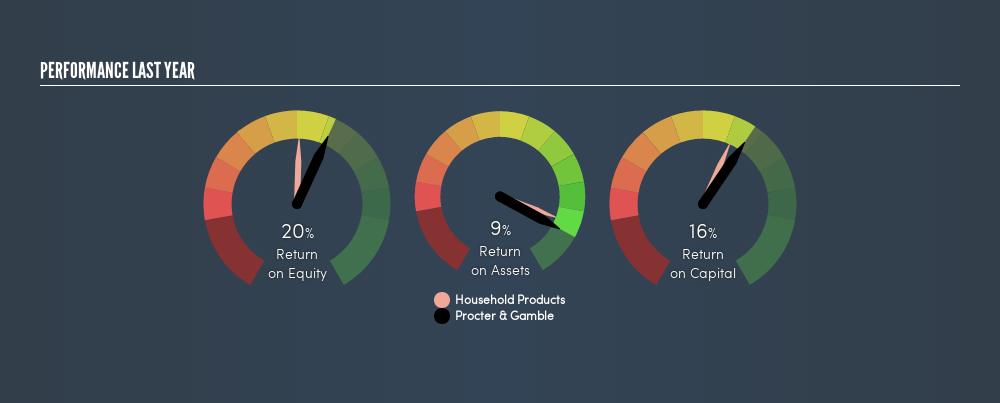- United States
- /
- Household Products
- /
- NYSE:PG
Do You Know About The Procter & Gamble Company’s (NYSE:PG) ROCE?

Want to participate in a short research study? Help shape the future of investing tools and receive a $20 prize!
Today we'll evaluate The Procter & Gamble Company (NYSE:PG) to determine whether it could have potential as an investment idea. Specifically, we'll consider its Return On Capital Employed (ROCE), since that will give us an insight into how efficiently the business can generate profits from the capital it requires.
First of all, we'll work out how to calculate ROCE. Then we'll compare its ROCE to similar companies. Then we'll determine how its current liabilities are affecting its ROCE.
What is Return On Capital Employed (ROCE)?
ROCE is a metric for evaluating how much pre-tax income (in percentage terms) a company earns on the capital invested in its business. All else being equal, a better business will have a higher ROCE. Ultimately, it is a useful but imperfect metric. Renowned investment researcher Michael Mauboussin has suggested that a high ROCE can indicate that 'one dollar invested in the company generates value of more than one dollar'.
So, How Do We Calculate ROCE?
Analysts use this formula to calculate return on capital employed:
Return on Capital Employed = Earnings Before Interest and Tax (EBIT) ÷ (Total Assets - Current Liabilities)
Or for Procter & Gamble:
0.16 = US$15b ÷ (US$124b - US$31b) (Based on the trailing twelve months to December 2018.)
Therefore, Procter & Gamble has an ROCE of 16%.
Check out our latest analysis for Procter & Gamble
Is Procter & Gamble's ROCE Good?
ROCE can be useful when making comparisons, such as between similar companies. Using our data, Procter & Gamble's ROCE appears to be around the 14% average of the Household Products industry. Independently of how Procter & Gamble compares to its industry, its ROCE in absolute terms appears decent, and the company may be worthy of closer investigation.

Remember that this metric is backwards looking - it shows what has happened in the past, and does not accurately predict the future. ROCE can be deceptive for cyclical businesses, as returns can look incredible in boom times, and terribly low in downturns. ROCE is only a point-in-time measure. What happens in the future is pretty important for investors, so we have prepared a freereport on analyst forecasts for Procter & Gamble.
What Are Current Liabilities, And How Do They Affect Procter & Gamble's ROCE?
Current liabilities include invoices, such as supplier payments, short-term debt, or a tax bill, that need to be paid within 12 months. Due to the way the ROCE equation works, having large bills due in the near term can make it look as though a company has less capital employed, and thus a higher ROCE than usual. To counteract this, we check if a company has high current liabilities, relative to its total assets.
Procter & Gamble has total assets of US$124b and current liabilities of US$31b. Therefore its current liabilities are equivalent to approximately 25% of its total assets. Current liabilities are minimal, limiting the impact on ROCE.
What We Can Learn From Procter & Gamble's ROCE
Overall, Procter & Gamble has a decent ROCE and could be worthy of further research. But note: Procter & Gamble may not be the best stock to buy. So take a peek at this freelist of interesting companies with strong recent earnings growth (and a P/E ratio below 20).
If you like to buy stocks alongside management, then you might just love this freelist of companies. (Hint: insiders have been buying them).
We aim to bring you long-term focused research analysis driven by fundamental data. Note that our analysis may not factor in the latest price-sensitive company announcements or qualitative material.
If you spot an error that warrants correction, please contact the editor at editorial-team@simplywallst.com. This article by Simply Wall St is general in nature. It does not constitute a recommendation to buy or sell any stock, and does not take account of your objectives, or your financial situation. Simply Wall St has no position in the stocks mentioned. Thank you for reading.
About NYSE:PG
Procter & Gamble
Engages in the provision of branded consumer packaged goods worldwide.
Solid track record established dividend payer.
Similar Companies
Market Insights
Community Narratives



